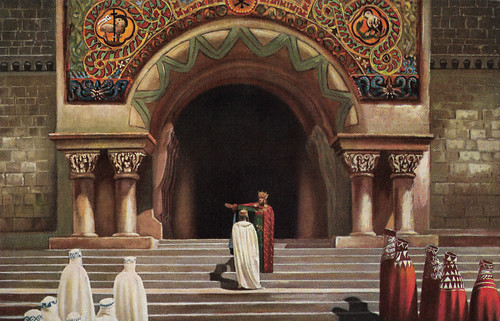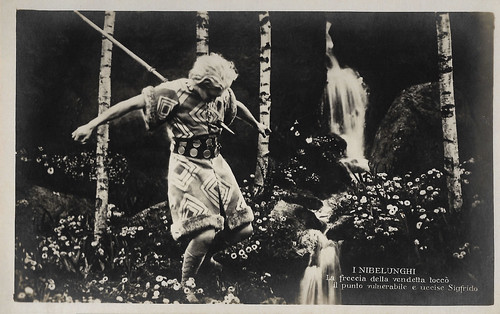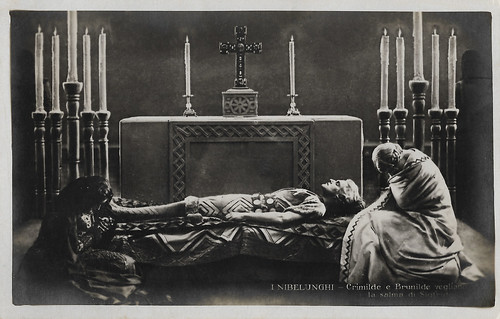
German postcard by Uvachrom, series 405, no. 5433. Photo: Ufa. Die Nibelungen I (Fritz Lang, 1924). Caption: Siegfried's sword.
How Siegfried Slayed the Dragon
Die Nibelungen was produced by the Ufa and Decla studios, and it starred Austrian actor Paul Richter as the (nearly) invulnerable hero Siegfried. The screenplays were written by Fritz Lang and his wife at the time, Thea von Harbou. They were based upon the epic Nordic poem 'Nibelungenlied', written around AD 1200 and told through seven cantos.

German postcard by Uvachrom, series 405, no. 5434. Photo: Ufa. Paul Richter as Siegfried in Die Nibelungen I (Fritz Lang, 1924). Caption: The lime leaf.
It is the tale of the legendary German hero Siegfried (Paul Richter), son of King Siegmund. He masters the art of forging a sword at the shop of Mime (Georg John). On his journey home, he hears tales from the locals about Princess Kriemhild (Margarete Schön), the beautiful sister of King Gunter of Burgundy (Theodor Loos).

Italian postcard by G. Vettori, Bologna. Paul Richter and Georg John in Die Nibelungen (Fritz Lang, 1924). Caption: Die Nibelungen - Mime tries to betray Siegfried by putting him on the wrong track -.
Siegfried decides to go to Worms, the capital of Burgundy, to win Kriemhild. On his journey to Worms, he is attacked by a dragon. Siegfried slays the dragon and bathes in his blood. This bath makes him invulnerable - except for one spot on his shoulder blade which is missed after being covered by a falling lime leaf.
How Volker, the Bard, sang of Siegfried in front of Kriemhild, and How Siegfried Came in Worms

Italian postcard by G. Vettori, Bologna. Paul Richter in Die Nibelungen (Fritz Lang, 1924).
Siegfried trespasses on the land of the Nibelungen and is attacked by Alberich, King of the Dwarves (again Georg John). He fights and defeats Alberich who was wearing his wonder cloak of invisibility and transformation. Alberich asks Siegfried to spare his life and in return, he gives the Treasure of the Nibelungen and the Balmung sword. While Siegfried is mesmerised by the treasure, Alberich tries to defeat him but dies in the attempt. Dying, Alberich curses all inheritors of the treasure and he and his dwarves turn to stone. Siegfried makes twelve kings as his vassals and arrives in Worms as a hero.
How Siegfried Won Brunhild for Gunther

Italian postcard by G. Vettori, Bologna. Hanna Ralph, as Brunhild in Die Nibelungen (Fritz Lang, 1924). Caption: Die Nibelungen - Siegfried - Brunhild.
News reaches the court that Brunhild, a queen of outstanding strength and beauty may be won only by a man capable of matching her athletic prowess. Gunther decides to woo Brunhild (Hanna Ralph) with the aid of Siegfried, to whom he promises the hand of Kriemhild if successful. The men travel to Iceland, to the kingdom of Brunhild, where Siegfried feigns vassalage to Gunther so that he can avoid Brunhild's challenge. He uses instead the cloak's power of invisibility to help Gunther beat the powerful Queen in a three-fold Amazonian battle of strength: throwing stones, throwing a spear and jumping.
How Brunhild Enters Worms and How the King Celebrate Their Wedding

German postcard by Uvachrom, series 405, no. 5435. Photo: Ufa. Die Nibelungen I (Fritz Lang, 1924). Caption: Brünhilde's entry.

Italian postcard by G. Vettori, Bologna. Margarete Schön in Die Nibelungen (Fritz Lang, 1924). Caption: Die Nibelungen - Siegfried ...you don't have to carry it - A terrible secret is locked in its short circle.
The men return to Burgundy where Gunther marries Brunhild and Siegfried weds Kriemhild. Brunhild is not, however, completely defeated. She suspects deceit and says to Gunther that she is his captive but not his bride. Hagen von Tronje (Hans Adalbert Schlettow) convinces Siegfried to help. Siegfried transforms himself with the cloak into Gunther and battles Brunhild and removes her arm ring during battle after which she submits to his will. Siegfried leaves the real Gunther to consummate the marriage. Siegfried accidentally brings Brunhild's armlet with him.
How After Half a Year, Siegfried's Gift to His Bride, The Nibelungen Treasure, Arrives in Worms and How the Two Queens Quarrel With Each Other

German postcard by Uvachrom, series 405, no. 5436. Photo: Ufa. Die Nibelungen I (Fritz Lang, 1924). Caption: The quarrel of the queens.
When Kriemhild finds Brunhild's armlet, Siegfried tells her how her brother won the queen. When the Nibelungen treasure that Siegfried acquired from Alberich arrives at the court of Burgundy as Kriemhild's morning gift, the jealous Brunhild becomes more suspicious about Siegfried's feigned vassalage to Gunther. Brunhild dons the Queen Mother's jewellery and proceeds to the cathedral to enter as the first person, as is her right as Queen of Burgundy. Kriemhild and Brunhild quarrel. Brunhild ridicules Kriemhild for marrying a vassal, and Kriemhild reveals Siegfried’s and Gunther’s deception.
How Gunther Betrayed Siegfried

German postcard by Uvachrome, Serie 405, no. 5437. Image: Watercolour after a famous still from Die Nibelungen I (Fritz Lang, 1924).

Italian postcard by G. Vettori, Bologna. Paul Richter as Siegfried in Die Nibelungen (Fritz Lang, 1924). Caption: Die Nibelungen - The arrow of vengeance touched the vulnerable spot and killed Siegfried.
Brunhild demands Siegfried be killed. She lies to Gunther and tells him that Siegfried stole her maidenhood when he battled her on her wedding night. King Gunther and his uncle and loyal warrior, Hagen von Tronje (Hans Adalbert Schlettow), conspire to murder Siegfried during a hunt in the Odenwald Forest. Hagen deceives Kriemhild into telling him the vulnerable part of Siegfried's body where the leaf has fallen. She sews a cross on the spot in Siegfried's tunic. After the hunt, Hagen challenges Siegfried to a race to a nearby spring. When Siegfried is on his knees drinking, Hagen pierces him from behind with a spear.
How Kriemhild Swears Revenge to Hagen Tronje

German postcard by Uvachrom, series 405, no. 5438. Photo: Ufa. Die Nibelungen I (Fritz Lang, 1924). Caption: Kriemhilde's Lament.

Italian postcard by G. Vettori, Bologna. Hanna Ralph, Paul Richter and Margarete Schön in Die Nibelungen (Fritz Lang, 1924). Caption: Die Nibelungen - Kriemhild and Brunhild watch over Siegfried's body.
In an evil twist of bitter revenge, Brunhild confesses that she lied about Siegfried stealing her maidenhood to avenge Gunther's deceit of her. Gunther killed his only loyal friend. Kriemhild demands her family avenge her husband's death at the hands of Siegfried, but her family is complicit in the murder, and so they protect Hagen. Kriemhild swears revenge against Hagen while a guilt-ridden Brunhild commits suicide at the foot of Siegfried's corpse laid in state in the cathedral. Kriemhild swears revenge to Hagen.

Italian postcard by G. Vettori, Bologna. Hans Adalbert Schlettow as Hagen, Theodor Loos as Gunter, Paul Richter as Siegfried and Margarete Schön as Kriemhild in Die Nibelungen (Fritz Lang, 1924). Caption: Die Nibelungen - You must avenge me King Gunter - Hagen of Tronje killed my groom.
Kriemhild's Revenge

German postcard by Uvachrom, series 405, no. 5653. Photo: Ufa. Die Nibelungen II (Fritz Lang, 1924). Caption: Rüdiger, King Etzel's Bride wooer.

German postcard by Uvachrom, series 405, no. 5654. Photo: Ufa. Die Nibelungen II (Fritz Lang, 1924). Caption: Kriemhild's Entry into Hun Country.
In the second film, Kriemhild's Rache/Kriemhild's Revenge, is shown how Kriemhild gets her revenge. After Siegfried's dead, Kriemhild marries Etzel, the King of the Huns. She gives birth to a child and invites her brothers to a party. She tries to persuade Etzel and the other Huns, that they kill Hagen, the murderer of Siegfried, but he is protected by her brothers. A fierce battle begins to force her brothers to give Hagen to her.
Probably no literary work has given more to Germanic arts than the 'Nibelungenlied'. Many variations and adaptations appeared through the centuries. The most significant modern adaptation is Richard Wagner’s famous opera cycle 'Der Ring des Nibelungen' (1853–1874). The 1924 film Die Nibelungen is still astounding to look at. Fritz Lang gives the film a real sense of wonder by way of fantasy elements such as dwarfs, dragons and magic powers. Amazingly, such a masterpiece of cinema could have been made in the early 1920s. The standout is the dragon-slaying scene with its wonderful special effects.

German postcard by Uvachrom, series 405, no. 5656. Photo: Ufa. Die Nibelungen II (Fritz Lang, 1924). Caption: The grim Hagen.
Sources: Claudio Carvalho (IMDb), Thomas Staedeli (Cyranos), Encyclopedia Britannica, IMDb and Wikipedia.
No comments:
Post a Comment